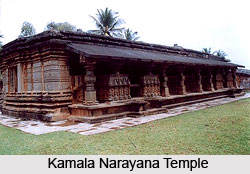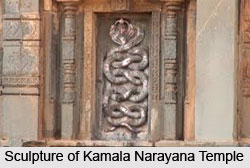 Kamala Narayana Temple is an ancient temple located at Degaon, also known as Degamve or Devgram in Belgaum district of the Indian state Karnataka. It is a Kadamba style temple and the complex has probably rendered name to the place as Devagrama, which refers to a village of God. It was constructed in 12th century by Kamaladevi, the Kadamba queen. The temple is famed for its spellbinding sculptural adornments among which the floral and lion motifs and dancing girls find special mention.
Kamala Narayana Temple is an ancient temple located at Degaon, also known as Degamve or Devgram in Belgaum district of the Indian state Karnataka. It is a Kadamba style temple and the complex has probably rendered name to the place as Devagrama, which refers to a village of God. It was constructed in 12th century by Kamaladevi, the Kadamba queen. The temple is famed for its spellbinding sculptural adornments among which the floral and lion motifs and dancing girls find special mention.
History of Kamala Narayana Temple
In ancient India, temple building was the forte of the Kadambas who were famed for their unique style. Mayurasharma was the founder of this dynasty who established it in 4th century AD. Belgaum district and Halasi served as their second capital which house a few temples constructed by the Kadamba rulers out of which the Kamala Narayana Temple in Devgram is much renowned. The beauty of the temple is also believed to have impressed the Hoyosalas which inspired them to use similar architectural style in their temples.
Architecture of Kamala Narayana Temple
The Kadamba style of architecture is characterized by the tapering terraced tower forming a perfect pyramid and dynamic line of each terrace, prominent from even a long distance. Kamala Narayana Temple is believed to exhibit the pinnacle of perfection of this style.
 It has a rectangular structure comprising three cells and a pillared hall which runs from north to south before the shrines located on the west side. Each of the shrines has been divided into two parts namely Sukhanasi and Garbhagriha. Sukhanasi has beautiful doorways with frames embellished with carved creepers. There are stone windows surrounding the doorways which add to its architectural beauty more than any other Kadamba temple. The Garbhagihas house the dedicatory block with an image of Gaja-Lakshmi. The ceiling of the temple is adorned with pendant lotuses showcasing brilliant and rich artistic works.
It has a rectangular structure comprising three cells and a pillared hall which runs from north to south before the shrines located on the west side. Each of the shrines has been divided into two parts namely Sukhanasi and Garbhagriha. Sukhanasi has beautiful doorways with frames embellished with carved creepers. There are stone windows surrounding the doorways which add to its architectural beauty more than any other Kadamba temple. The Garbhagihas house the dedicatory block with an image of Gaja-Lakshmi. The ceiling of the temple is adorned with pendant lotuses showcasing brilliant and rich artistic works.
Cells of Kamala Narayana Temple
The three cells of the temple shelter different images of deities. The first cell has an image of Narayana. The second one has the idol of Lakshmi-Narayana along with Lakshmi, seated on the lap of Lord Vishnu. On either side of this idol stand Garuda and Maruti. The third cell of the temple contains image of Kamala and two attendants on its either side.
Walls of Kamala Narayana Temple
The walls of the temple are profusely decorated with plastered niche which are further surmounted by terraced pyramidal towers exhibiting Kadamba style crowning with a Kalasha on the parapets that surround the Mukhamandapa. Several friezes have been made for ornamentation. Prominent friezes show beautiful scroll work, pillars with roaring lions between them and pyramidal towers over the pillars with dancing girls in varied poses.





















